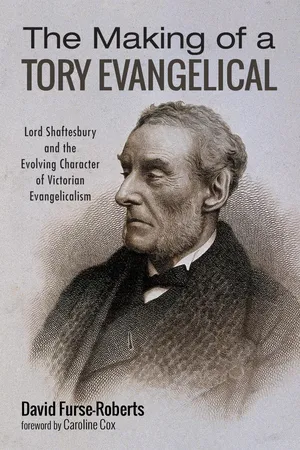![]()
Part I
Ashley and the Anglican Evangelical Tradition
![]()
1
Ashley’s Expression of Anglican Evangelicalism
In the twilight of his long life in 1884, Ashley described himself as an “Evangelical of the Evangelicals.” The Evangelical identity of this Victorian social reformer and philanthropist is widely appreciated by both the biographical works and the historiography of Evangelical religion in the Victorian period. Given the fluid and heterogeneous nature of Evangelicalism in eighteenth- and nineteenth-century Britain, however, this first section will seek to explore the manner and extent to which Ashley embodied the various Evangelical characteristics as identified by the historians of this religious movement. Identifying the Established Church of England as the institution through which the Evangelicalism of Ashley was conditioned, this section will discuss some of the key Anglican institutions, networks, and leaders primarily responsible for configuring both the praxis and theology of the Evangelicalism that Ashley came to imbibe as a young man in the 1820s and 1830s. This period of British history during which Ashley assented to Evangelicalism is particularly significant given the historiographical consensus that this was also the precise point at which Evangelicalism underwent considerable ferment and transformation. According to the accepted narrative, Evangelicalism, whilst retaining its fundamentals of belief and practice, changed appreciably in temperament and disposition during the second quarter of the nineteenth century from being the rationalist, measured, and postmillennial variety of Charles Simeon and the Clapham Sect generation to the more strident, ultra-Protestant, and premillennial version of Alexander Haldane and the Recordites. Evangelicalism thus experienced a combination of change and continuity during this generational transition. This essentially accorded with Bebbington’s theory that the relationship between successive Evangelical generations “was one of continuity as well as discontinuity.”
With the earlier half of Ashley’s life spanning these two generations, he witnessed first-hand this Evangelical transformation and his personal faith accordingly reflected elements of each. This was captured by Edwin Hodder who catalogued a string of Evangelical figures from both the Clapham and Recordite traditions with whom Ashley was seen to be connected.
Of the first generation, Hodder appropriately associated the fellow of King’s College Cambridge, Charles Simeon, and the Bible commentator, Thomas Scott, with Ashley and his Evangelicalism. Although Ashley was not known to have enjoyed a personal acquaintance with Simeon, the Cambridge leader’s zeal for overseas mission and evangelism amongst the Jews was transmitted through another Anglican clergyman, Edward Bickersteth, who became a personal mentor to Ashley. Meanwhile, Ashley inherited Scott’s reverence for the divine inspiration of scripture through the reading of his influential Bible commentaries. The other ‘older order’ Evangelical figures that Hodder cited, on the other hand, were peripheral and not closely connected with Ashley’s spiritual formation. Of the more recent school, again, it was a select number, namely Bickersteth and the Record proprietor, Alexander Haldane, with whom Ashley was closely acquainted. Although Ashley was initially cool towards the Record for what he saw as its polemical tone, he came to appreciate Haldane as a kindred spirit in his similarly premillennial and uncompromisingly Protestant expression of Evangelicalism. It was Hodder’s reference to Bickersteth, however, that was particularly noteworthy, not only on account of his intimate friendship with, and far-reaching influence on Ashley, but also on his status as a ‘transitional’ Evangelical bridging the Claphamite and Recordite gulf. Accordingly, this section will conclude that chiefly by virtue of Bickersteth’s influence, Ashley similarly represented an intermediary figure in the transformation of British Evangelicalism during the 1820s and 1830s.
The emergence of Anglican Evangelicalism and Ashley
The Evangelical Protestant expression of Christianity took root with a religious revival bursting forth on the English scene from the 1730s through the dynamic preaching activity of the Wesley brothers and Whitefield. Notwithstanding the diversity of theological perspectives and emphases within evangelicalism, not least the Arminian-Calvinist controversy between the movement’s two figureheads John Wesley and George Whitefield, Bebbington was able to formulate a ‘quadrilateral’ of doctrinal hallmarks underpinning this religious tradition. First, Evangelicalism could be defined by its conversionism with the belief that lives needed to be transformed by the power of Christ and his Holy Spirit; second, the movement was characterized by its activism with the practical application of the gospel in activity such as mission and philanthropy; third, this religious tradition was marked by biblicism with its high view of the Bible; and fourth, Evangelicalism was distinctive because of its crucicentrism which stressed the sacrifice of Christ on the cross to atone for the sins of humanity. Appropriately, Bebbington’s quadrilateral had Victorian roots with two earlier formulations of Evangelicalism proposed by the Anglican reviewer, W. J. Conybeare, in 1853 and the Anglican Evangelical leader, J. C. Ryle, in 1867.
Far from representing a static formulation of evangelical thought or a one-size-fits-all descriptor of evangelicals, however, Bebbington appreciated that the shape of this quadrilateral was subject to change according to the broader historical context and recognized that different evangelical figures and movements would emphasize some characteristics to a greater degree than others. John Wesley, for example, gave special emphasis to conversionism and...
